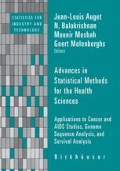Abstract
Early stopping of clinical trials either in the case of beneficial or deleterious effect of treatment on quality of life (QoL) is an important issue. QoL is usually evaluated using self-assessment questionnaires and responses to the items are combined into scores assumed to be normally distributed (which is rarely the case). An alternative is to use item response theory (IRT) models such as the partial credit model (PCM) for polytomous items which takes into account the categorical nature of the items.
Sequential analysis and mixed partial credit models were combined in the context of phase II noncomparative trials. The statistical properties of the sequential probability ratio test (SPRT) and of the triangular test (TT) were compared using mixed PCM and traditional average scores methods (ASM) by means of simulations.
The type I error of the sequential tests was correctly maintained for both methods, the mixed PCM being more conservative than the ASM. Although remaining a bit underpowered, the mixed PCM displayed higher power than the ASM for both sequential tests. Both methods allowed substantial reductions in average sample numbers as compared with fixed sample designs. Overlapping of item category particularly affected the ASM by inflating the type I error and power. The use of IRT models in sequential analysis of QoL endpoints is promising and should provide a more powerful method to detect therapeutic effects than the traditional ASM.
Access this chapter
Tax calculation will be finalised at checkout
Purchases are for personal use only
Preview
Unable to display preview. Download preview PDF.
References
Andersen, E. B. (1977). Estimating the parameters of the latent population distribution, Psychometrika, 42, 357–374.
Cannistra, S. A. (2004). The ethics of early stopping rules: Who is protecting whom? Journal of Clinical Oncology, 22, 1542–1545.
Cella, D. F., and Bonomi, A. E. (1995). Measuring quality of life: 1995 update, Oncology, 9, 47–60.
Fairclough, D. L. (2002). Design and Analysis of Quality of Life Studies in Clinical Trial, Chapman and Hall/CRC, Boca Raton, Florida.
Fisher, G. H., and Molenaar, I. W. (1995). Rasch Models, Foundations, Recent Developments, and Applications, Springer-Verlag, New York.
Grossman, J., Parmar, M. K., Spiegelhalter, D. J., and Freedman, L. S. (1994). A unified method for monitoring and analysing controlled trials, Statistics in Medicine, 13, 1815–1826.
Hamon, A., and Mesbah, M. (2002). Questionnaire reliability under the Rasch model, In Statistical Methods for Quality of Life Studies: Design, Measurements and Analysis (Eds., M. Mesbah, B. F. Cole, and M. L. T. Lee), Kluwer, Amsterdam, The Netherlands.
Holman, R., Glas, C. A., and de Haan, R. J. (2003a). Power analysis in randomized clinical trials based on item response theory, Controlled Clinical Trials, 24, 390–410.
Holman, R., Lindeboom, R., Glas, C. A. W., Vermeulen M., and de Haan, R. J. (2003b). Constructing an item bank using item response theory: The AMC linear disability score project, Health Services Outcome Research Methods, 4, 19–33.
Jennison, C., and Turnbull, B. W. (1999). Group Sequential Methods with Applications to Clinical Trials, Chapman and Hall/CRC, Boca Raton, Florida.
Kosinski, M., Bjorner, J. B., Ware, J. E. Jr, Batenhorst, A., and Cady R. K. (2003). The responsiveness of headache impact scales scored using ‘classical’ and ‘modern’ psychometric methods: A re-analysis of three clinical trials, Quality of Life Research, 12, 903–912.
Lan, K. K. G., and De Mets, D. L. (1983). Discrete sequential boundaries for clinical trials, Biometrika, 70, 659–663.
Masters, G. N. (1982). A Rasch model for partial credit scoring, Psychometrika, 47, 149–174.
McHorney, C. A., Haley, S. M., and Ware, J.E. Jr. (1997). Evaluation of the MOS SF-36 Physical Functioning Scale (PF-10): II. Comparison of relative precision using Likert and Rasch scoring methods, Journal of Clinical Epidemiology, 50, 451–461.
Pinheiro, J. C., and Bates, D. M. (1995). Approximations to the log-likelihood function in the nonlinear mixed-effects model, Journal of Computational and Graphical Statistics, 4, 12–35.
Sébille, V., and Bellissant, E. (2001). Comparison of the two-sided single triangular test to the double triangular test, Controlled Clinical Trials, 22, 503–514.
Sébille, V., and Mesbah, M. (2006). Sequential Analysis of Quality of Life Rasch Measurements, In Probability, Statistics and Modelling in Public Health, (Eds., M. Nikulin, D. Commenges, and C. Huber) Springer-Verlag, New York.
Siegmund, D. (1979). Corrected diffusion approximations in certain random walk problems, Advances in Applied Probability, 11, 701–719.
Thissen, D. (1982). Marginal maximum likelihood estimation for the one-parameter logistic model, Psychometrika, 47, 175–186.
Wald, A. (1947). Sequential Analysis, John Wiley & Sons, New York.
Whitehead, J. (1997). The Design and Analysis of Sequential Clinical Trials, Second edition, John Wiley & Sons, Chichester, U.K.
Author information
Authors and Affiliations
Editor information
Editors and Affiliations
Rights and permissions
Copyright information
© 2007 Birkhäuser Boston
About this chapter
Cite this chapter
Sébille, V., Challa, T., Mesbah, M. (2007). Sequential Analysis of Quality of Life Measurements with the Mixed Partial Credit Model. In: Auget, JL., Balakrishnan, N., Mesbah, M., Molenberghs, G. (eds) Advances in Statistical Methods for the Health Sciences. Statistics for Industry and Technology. Birkhäuser Boston. https://doi.org/10.1007/978-0-8176-4542-7_7
Download citation
DOI: https://doi.org/10.1007/978-0-8176-4542-7_7
Publisher Name: Birkhäuser Boston
Print ISBN: 978-0-8176-4368-3
Online ISBN: 978-0-8176-4542-7
eBook Packages: Mathematics and StatisticsMathematics and Statistics (R0)

